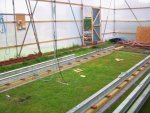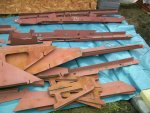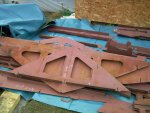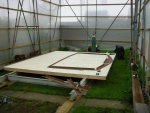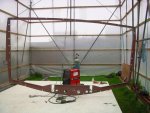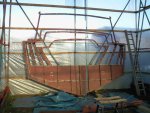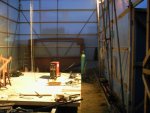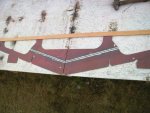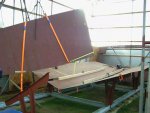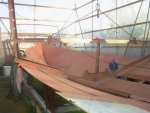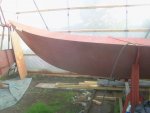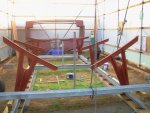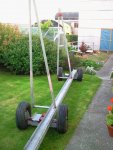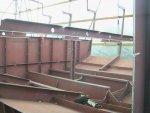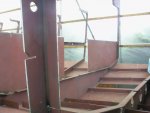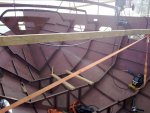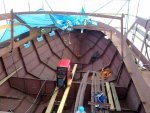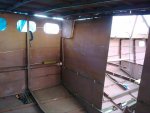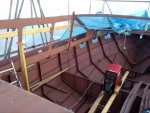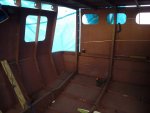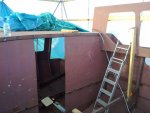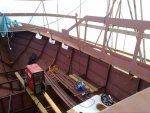JOHNPEET
Well-known member
As requested by some of the members of the forum on my post regarding boat transport by road - I’m going to share some of the photos that I’ve taken of my boat building project that I’ve undertaken over the last eleven years or so along with a bit of a storyline/explanation of the photos posted.
The boat is an Almarine 1200fa - the hull itself is a touch under 12m overall which is extended to about 12.7m with the addition of the swim platform and is 4.3m beam. Design draught is 1.2m. The hull is a steel kit designed by Hans Alma and supplied to myself by Bonito Boats in the Netherlands, which Hans owned and managed at the time. The first photo below is of a completed boat(not mine) which was based in Bristol - just to give you an idea of what is looks like.
Just a quick about the project that I’m going to share with you. The project has required many decisions to be taken about all sorts of aspects of what will be the finished boat. The decisions made are mine. Those decisions were made on a whole host of reasons and issues be it financial, limitations on my practical skills, limitations on the availability of equipment or simple personal preference. The decisions and choices that I made at the time may differ from those that you would have taken, but then your circumstances and limitations would have been different to mine! I’m very happy with what you will see as the end result and it is more than adequate for what I and my family need and intend to enjoy. I hope you enjoy my journey!
Do I have any regrets - yes, the obvious one being I wished I could have finished it in half the time! ?
The steel kit was ordered from Bonito Boats in late summer 2009 and arrived with me around Oct 2009.
The steel was all offloaded at my in-laws farm and put into one of their sheds for dry storage. We then moved it from there by tractor and trailer in three separate loads as i needed the various parts. The farm is about six miles from my house (The build site
After considering a number of various options, I had finally decided to use my garden as a build site and this is something that I have been so thankful for. It’s meant that I could just pop out at any time to work on the boat and make use of my workshop for whatever I need. Having to travel any distance to the build site would have been a nightmare!
So the first batch of photos that I’m going to share with you is of the weatherproof shelter that I built between April and Aug 2010. The shelter needed planning permission! I also have good neighbours!
If you look carefully at the last of the photos, you should be able to make out the gantry that I made for lifting and moving the steel and engines etc.
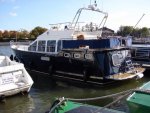
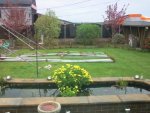
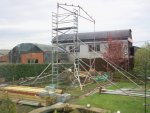
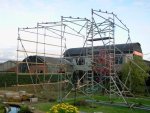
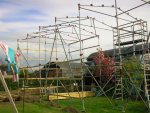
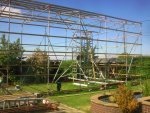

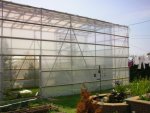
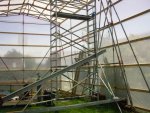
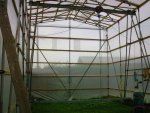
The boat is an Almarine 1200fa - the hull itself is a touch under 12m overall which is extended to about 12.7m with the addition of the swim platform and is 4.3m beam. Design draught is 1.2m. The hull is a steel kit designed by Hans Alma and supplied to myself by Bonito Boats in the Netherlands, which Hans owned and managed at the time. The first photo below is of a completed boat(not mine) which was based in Bristol - just to give you an idea of what is looks like.
Just a quick about the project that I’m going to share with you. The project has required many decisions to be taken about all sorts of aspects of what will be the finished boat. The decisions made are mine. Those decisions were made on a whole host of reasons and issues be it financial, limitations on my practical skills, limitations on the availability of equipment or simple personal preference. The decisions and choices that I made at the time may differ from those that you would have taken, but then your circumstances and limitations would have been different to mine! I’m very happy with what you will see as the end result and it is more than adequate for what I and my family need and intend to enjoy. I hope you enjoy my journey!
Do I have any regrets - yes, the obvious one being I wished I could have finished it in half the time! ?
The steel kit was ordered from Bonito Boats in late summer 2009 and arrived with me around Oct 2009.
The steel was all offloaded at my in-laws farm and put into one of their sheds for dry storage. We then moved it from there by tractor and trailer in three separate loads as i needed the various parts. The farm is about six miles from my house (The build site
After considering a number of various options, I had finally decided to use my garden as a build site and this is something that I have been so thankful for. It’s meant that I could just pop out at any time to work on the boat and make use of my workshop for whatever I need. Having to travel any distance to the build site would have been a nightmare!
So the first batch of photos that I’m going to share with you is of the weatherproof shelter that I built between April and Aug 2010. The shelter needed planning permission! I also have good neighbours!
If you look carefully at the last of the photos, you should be able to make out the gantry that I made for lifting and moving the steel and engines etc.











